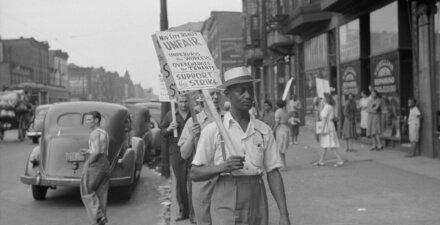Enacting a minimum wage for tipped workers is on the ballot in two U.S. cities. Here’s what the research says

In most cities and states across the United States, servers and other so-called front-of-house staff in the restaurant industry earn a subminimum wage for tipped workers. Whether and how this long-established and historically racist and gender discriminatory two-tiered compensation system harms these restaurant workers to the benefit of restaurant firms is the subject of increased debate across the country. The reason: there are ballot initiatives this month to enact fixed minimum wages for tipped workers in Washington, DC and Portland, Maine, and the idea is highly debated in other cities and states across the nation.
So, what do the economic data tell policymakers—and the general public weighing the merits of these ballot initiatives—about the impact of the subminimum tipped wage on servers in the restaurant industry and about the efficacy of enacting a standard minimum wage for these workers? There are a number of research papers that examine the practice of tipping in worker outcomes, as well as the broader impact of a subminimum wage for tipped workers on the U.S. labor market. As cities and states across the country navigate debates on subminimum wages and whether to abolish their existence in favor of one fair wage, this column elevates the scholarly research to help inform this debate.
But first, it’s important to provide some context and some history about the tipped subminimum wage. The subminimum wage for tipped workers at the federal level stands at $2.13 per hour—far below the federal minimal wage of $7.25 per hour—but varies by state and city across the country. In some locations, the subminimum wage is higher than the federal level of $2.13 but still below the federal minimum of $7.25. In West Virginia, for example, the subminimum wage is $2.63, 50 cents more than the federal subminimum. And in seven states, as well as the territory of Guam, there is no subminimum wage for tipped workers, meaning all workers in these states earn the statutory minimum even in industries where tipping is common, including in the large state economy of California.
These state- and municipal-level reforms to the tipped minimum wage reflect efforts to address widespread wage theft and income volatility among tipped workers. The history of tipping’s roots in the larger structural racism of the U.S. labor market is an important consideration, too. Tipping was a practice that justified meager wages for Black workers in service occupations, such as railroad porters and bellmen in the 19th century, which spread quickly to the then-growing hospitality industry to include waiters and waitresses, resulting in rising gender wage discrimination, too, in restaurants.
While there was movement in the early 1900s to end the practice of tipping, business opposition to banning tipping in favor of a fixed wage resulted in tipped occupations being excluded from the introduction of the federal statutory minimum wage in the Fair Labor Standards Act of 1938. Even though federal law today stipulates that workers need to be paid the difference between the subminimum and the minimum wage if a worker’s tips are insufficient to match the difference, workers in many states and cities rarely receive this additional payment from their employers. As a result, de facto wage theft is rampant in the restaurant industry to this day.
So, what does the economic research tell us today about the consequences of the subminimum tipped wage for servers in the restaurant industry? Do reforms to the tipped minimum wage increase the wages of these workers overall? Or do reforms actually lead to decreased earnings for servers, as is believed by many in the restaurant industry? And does raising the tipped minimum wage have any discernible impact on employment outcomes for servers overall in the restaurant industry?
The economics research on the impact of the subminimum wage on these workers is somewhat ambiguous, finding some or no improvement in wages and unclear impacts for employment levels. But against the backdrop of low earnings for many workers in food and beverage serving occupations, efforts to stabilize wages by abolishing the subminimum wage for tipped workers may reduce the likelihood of wage theft and ensure that marginalized groups are not further disadvantaged. Additionally, abolishing the subminimum wage can reduce earnings volatility, which can have subsequent impacts on workers and their families.
Let’s now briefly examine some of this research.
Economists Sylvia Allegretto and Carl Nadler at the University of California, Berkeley find in their 2015 report, “Tipped Wage Effects on Earnings and Employment in Full-Service Restaurants,” that a 10 percent increase in wages for tipped workers in full-service restaurants increases earnings by 0.4 percent, with no discernible impact on employment levels. In contrast, economists William E. Evan at Miami University in Ohio and David A. MacPherson at Trinity University find in their 2013 paper, “The Effect of the Tipped Minimum Wage on Employees in the U.S. Restaurant Industry,” that earnings do go up, but employment goes down.
The ambiguity of these findings between marginally higher earnings but possible downside effects on employment levels could be troublesome for policymakers, but the earnings stability for these workers found by both pairs of researchers is certainly a worthwhile economic policy objective. What’s more, those restaurant workers most in need of earnings stability—young, low-income workers with families to care for—are particularly vulnerable to the clear downsides of subminimum tipped wages. Sociologists Michelle Maroto at the University of Alberta and David Pettinicchio at the University of Toronto find in their 2022 paper, “Worth Less? Exploring the Effects of the Subminimum Wage on Poverty Among U.S. Hourly Workers,” that subminimum wages were associated with increases in family poverty by 1.4 percentage points.
Maroto and Pettinicchio, however, do find that in some instances, having youth and students working for a subminimum tipped wage was associated with a decrease in family poverty, but also that subminimum wage work “compounded already high poverty rates for hourly workers with disabilities.” Further research that disaggregates the data in the subminimum tipped wage by age, gender, race, and household income would certainly be welcome, not least because the restaurant industry often showcases a carefully selected group of tipped employees who are garnering high levels of tips, as if the size of these tips is uniform across the industry when aggregated together. Advocates for tipped minimum wages find that is not the case.
Other research examining how restaurant servers in particular benefit in terms of total wages in states and cities with a fixed minimum wage, compared to those with subminimum tipped wages still in place, finds that minimum wage policy reforms are not worthwhile. Economists John E. Anderson at the University of Nebraska at Lincoln and Őrn B. Bodvarsson Westminister College in Salt Lake City find in a 2005 paper, “Do higher tipped minimum wages boost server pay?” that “1999 data on waitpersons and bartenders” show little evidence that there is a wage premium for these workers “in states with more generous minimum wages.”
It is important to emphasize, however, that similar outcomes across states refute outsized claims that getting rid of the subminimum wage will be disastrous for workers who would be subject to fair wage laws and the industries in which they work. Research in 2016 by economist T. William Lester at San José State University, for example, captures some important other factors related to higher labor standards in full-service restaurants in San Francisco, where fair wage standards were enacted several years ago, compared to the Research Triangle Park in North Carolina, where subminimum tipped wages remain the standard. He finds a number of important effects from the introduction of fair wage laws in the former market and the continuation of monopsonistic labor practices in the latter. Yet Lester also finds that neither the servers nor the restaurants in either place registered demonstrably terrible results from reform on the one hand and no reform on the other.
And then, there’s the broader question of family well-being—specifically, the quality of the future human capital of the children of restaurant workers in the United States. Epidemiologists Sarah Andrea at the University of Washington School of Public Health and her four co-authors at the Oregon Health and Science University’s School of Public Health conducted a nationwide investigation of the impact of the tipped worker subminimum wages on the gestational period of infants born to restaurant workers. They find that infants born to mothers working for subminimum wages have lower birth weights—one key negative factor in the subsequent physical and mental development of those infants. The five researchers conclude that “increasing the subminimum wage may be one strategy to promote healthier birthweight in infants,” which, in turn, would improve the future economic well-being of those children.
Clearly, economic debates about whether a subminimum wage for tipped workers increases wages on the margin or reduces employment on the margin is not the whole story when it comes to restaurant workers and their families. Earnings stability and the consequences for family economic well-being need to be considered in the mix, too.






